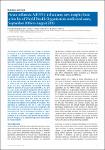Avian influenza A(H5N1) in humans: new insights from a line list of World Health Organization confirmed cases, September 2006 to August 2010
Fiebig, Lena
Soyka, Jana
Buda, Silke
Buchholz, Udo
Dehnert, Manuel
Haas, Walter
The threat of avian influenza (AI) viruses to humans in Europe in 2005 prompted the Robert Koch Institute to establish a routine monitoring instrument condensing information on all human AI cases worldwide reported from the World Health Organization (WHO) and other sources into a line list for further analysis. The 235 confirmed AI cases captured from September 2006 to August 2010 had a case fatality rate of 56% (132/235), ranging from 28% (27/98) in Egypt to 87% (71/82) in Indonesia. In a multivariable analysis, odds of dying increased by 33% with each day that passed from symptom onset until hospitalisation (OR: 1.33, p=0.002). In relation to children of 0–9 years, odds of fatal outcome were more than six times higher in 10–19 year-olds and 20–29 year-olds (OR: 6.06, 95% CI: 1.89–19.48, p=0.002 and OR: 6.16, 95% CI: 2.05–18.53, p=0.001, respectively), and nearly five times higher in patients of 30 years and older (OR: 4.71, 95% CI: 1.56–14.27, p=0.006) irrespective of the country, which had notified WHO of the cases. The situation in Egypt was special in that case number and incidence in children were more than twice as high as in any other age group or country. With this study, we show that data from the public domain yield important epidemiological information on the global AI situation. This approach to establish a line list is time-consuming but a line list is a prerequisite to such evaluations. We thus would like to encourage the placing of a publicly accessible line list of anonymised human AI cases, e.g. directly by WHO. This might enhance our understanding of AI in humans and permit the rapid detection of changes in its epidemiology with implications for human health.
No license information
Related Items
Show related Items with similar Title, Author, Creator or Subject.
-
2016-02-18ZeitschriftenartikelVaccine effectiveness in preventing laboratory-confirmed influenza in primary care patients in a season of co-circulation of influenza A(H1N1)pdm09, B and drifted A(H3N2), I-MOVE Multicentre Case–Control Study, Europe 2014/15 Valenciano, Marta; Kissling, Esther; Reuss, Annicka; Rizzo, C.; Gherasim, A.; Horváth, Judit K.; Domegan, L.; Pitigoi, Daniela; Machado, Ausenda; Bella, A.; Paradowska-Stankiewicz, I.; Larrauri, A.; Ferenczi, A.; O´Donell, Joan; Lazar, M.; Pechirra, P.; Korczyńska, M. R.; Pozo, Francisco; Moren, A.Influenza A(H3N2), A(H1N1)pdm09 and B viruses co-circulated in Europe in 2014/15. We undertook a multicentre case–control study in eight European countries to measure 2014/15 influenza vaccine effectiveness (VE) against ...
-
2016-10-13ZeitschriftenartikelImproving influenza virological surveillance in Europe: strain-based reporting of antigenic and genetic characterisation data, 11 European countries, influenza season 2013/14 Broberg, E.; Hungnes, Olav; Schweiger, Brunhilde; Prosenc, Katarina; Daniels, R.; Guiomar, R.; Ikonen, N.; Kossyvakis, A.; Pozo, Francisco; Puzelli, S.; Thomas, I.; Waters, A.; Wiman, Å.; Meijer, AdamInfluenza antigenic and genetic characterisation data are crucial for influenza vaccine composition decision making. Previously, aggregate data were reported to the European Centre for Disease Prevention and Control by ...
-
2013-02-14ZeitschriftenartikelEarly estimates of seasonal influenza vaccine effectiveness in Europe: results from the i-move multicentre case–control study, 2012/13 Valenciano, M.; Kissling, E.We conducted a test-negative case–control study based in five European sentinel surveillance networks. The early 2012/13 adjusted influenza vaccine effectiveness was 78.2% (95% CI: 18.0 to 94.2) against influenza B, 62.1% ...

